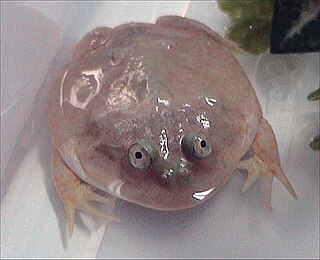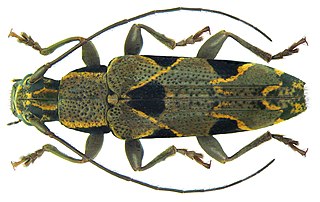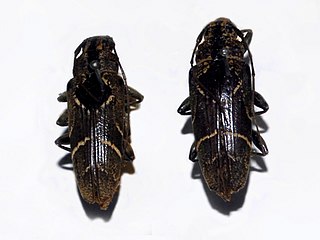
The African clawed frog is a species of African aquatic frog of the family Pipidae. Its name is derived from the three short claws on each hind foot, which it uses to tear apart its food. The word Xenopus means "strange foot" and laevis means "smooth".

Quercus laevis, the turkey oak, is a member of the red oak group of oaks. It is native to the southeastern United States, occurring on the coastal plain from Virginia south to central Florida, and west to southeast Louisiana. There they mingle with many tropical trees such as mature coconut palms and large Cuban Laurel (Ficus) trees. The name turkey oak derives from the resemblance of the leaves to a turkey's foot. A Turkish and southern European species Quercus cerris is also commonly referred to as Turkey oak, so Quercus laevis is sometimes referred to as American turkey oak to distinguish it from the European species.

Mirabilis is a genus of plants in the family Nyctaginaceae known as the four-o'clocks or umbrellaworts. The best known species may be Mirabilis jalapa, the plant most commonly called four o'clock.

Ulmus laevisPall., variously known as the European white elm, fluttering elm, spreading elm, stately elm and, in the United States, the Russian elm, is a large deciduous tree native to Europe, from France northeast to southern Finland, east beyond the Urals into Kyrgyzstan and Kazakhstan, and southeast to Bulgaria and the Crimea; there are also disjunct populations in the Caucasus and Spain, the latter now considered a relict population rather than an introduction by man, and possibly the origin of the European population. U. laevis is rare in the UK, although its random distribution, together with the absence of any record of its introduction, has led at least one British authority to consider it native. NB: The epithet 'white' elm commonly used by British foresters alluded to the timber of the wych elm.

Frogs have been used in animal tests throughout the history of biomedical science.
The European White Elm cultivar Ulmus laevis 'Aureovariegata', a yellow-variegated form, may have been the tree first listed, without description, in Hortus Regius Monacensis (1829) as Ulmus effusa variegata, grown at the Munich Botanic Garden. An Ulmus effusa fol. variegatis (Hort.) was first described c.1890 by the Späth nursery of Berlin, which distributed the tree in the late 19th century. The name U. effusa f. aureovariegata appeared in Beissner and Schelle's Handbuch der Laubholz-Benennung, 1903, without description.
The European White Elm cultivar Ulmus laevis 'Colorans' was listed as U. effusa var. colorans by Kirchner in Petzold & Kirchner, Arboretum Muscaviense (1864).
The European White Elm cultivar Ulmus laevis 'Punctata' was mentioned in 1873, 1889, and later in 1903 as U. effusa f. punctata, but without description.
Ulmus laevis var. celtideaRogow. is a putative variety of European White Elm first described by Rogowicz, who found the tree in 1856 along the river Dnjepr near Chernihiv in what is now northern Ukraine. The type specimen is held at the National Herbarium of Ukraine. The variety was first named as Ulmus pedunculata var. celtidea. Litvinov (1908) considered it a species, calling it Ulmus celtideaLitv., a view not upheld by other authorities.

Lepidobatrachus laevis, widely known as Budgett's frog, is a species of frog in the family Ceratophryidae, discovered by John Samuel Budgett. It is often kept as a pet. It has acquired a number of popular nicknames, including hippo frog, Freddy Krueger frog, and escuerzo de agua.

Plectropomus laevis, known commonly as the black-saddled coral grouper, cluespotted coral trout, blacksaddled coral trout, blue-spot trout, Chinese footballer, footballer cod, footballer coral trout, oceanic coral trout or tiger trout, is a species of marine ray-finned fish, a grouper from the subfamily Epinephelinae which is part of the family Serranidae, which also includes the anthias and sea basses. It is found in the Indo-Pacific region.
The European White Elm cultivar Ulmus laevis 'Urticifolia' known as the Nettle Leaved Elm was raised by Jacques as a chance seedling in 1830, and propagated by grafting. It was later mentioned by de Vries in 1906.
Ulmus laevis var. parvifolia is a mutant variety of European white elm found exclusively on the island of Ada Ciganlija, in the Sava at Belgrade, Serbia.

Tmesisternini is a tribe of beetles in the subfamily Lamiinae containing the following genera:

Tmesisternus is a genus of longhorn beetles belonging to the family Cerambycidae, subfamily Lamiinae.

The European White Elm cultivar Ulmus laevis 'Helena' is a Dutch introduction in commerce circa 2010 at the Boomkwekerij s'Herenland at Randwijk. The cultivar was cloned from a tree planted as one of a line of 17 White Elms at Eibergen circa 1900, which developed a straight central leader.
Tmesisternus jaspideus is a species of beetle in the family Cerambycidae. It was described by Jean Baptiste Boisduval in 1835.
Tmesisternus schaumii is a species of beetle in the family Cerambycidae. It was described by Francis Polkinghorne Pascoe in 1867. It is known from Moluccas, Australia, and the Solomon Islands.
The European White Elm cultivar Ulmus laevis 'Pendula' is a little-known cultivar of disputed taxonomy.

Protea laevis, also known as the smooth-leaf sugarbush, is a flowering shrub that belongs within the genus Protea.










